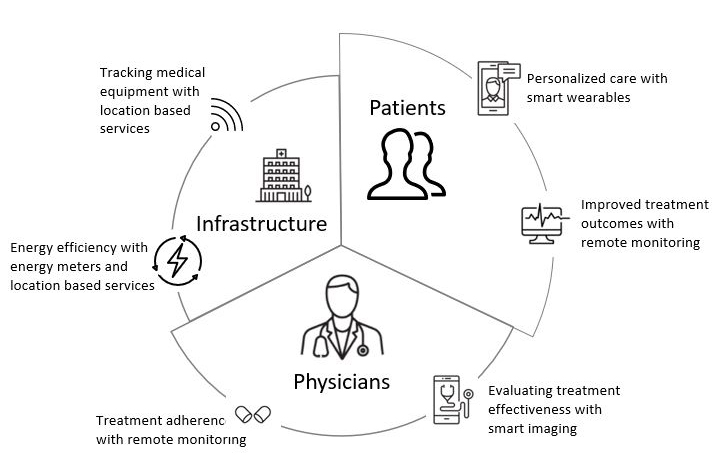Energy IQ: Three trends that will change the future of health care infrastructure
What does the future of health care look like? An increasingly connected, less centralized and more resilient infrastructure lies ahead.
By Aytek Yuksel, Content Marketing Leader - Power Systems

As we continue to look at the changing infrastructure of health care, we expect changes in three specific areas over the next decade.
Trend No. 1: A more connected health care infrastructure
Today - A combination of consumers accessing health care differently and the increased adoption of technology, ranging from Internet of Things (IoT) to artificial intelligence (AI), will lead to a more connected health care infrastructure.

As consumers increasingly use virtual visits, the health care industry will need to build facilities that can host tele-doctors and tele-nurses; and these facilities will need to be equipped with reliable connectivity to operate efficiently. Additionally, as consumers and the industry adopt IoT devices for tasks ranging from patient monitoring to imaging devices, there will be an increasing need to build the infrastructure supporting the technology.
Future - IoT devices will make more tasks dependent on electrical power while improving the facilities’ productivity. Facilities will seek a higher quality electricity supply for their sensitive IoT devices and be more critically dependent on reliable power sources to stay always on.
Opportunity – Health care companies balancing reliability and efficiency as they consume power could lead others in customer satisfaction and physician productivity. A power outage at a health care facility is already catastrophic today and it will get more damaging as the health care infrastructure gets more connected. Increased use of IoT devices in more medical tasks and facilities will make more patients vulnerable to power outages. Increasing virtual visits mean more medical staff at risk of losing productivity if the power is out.
Trend No. 2: A less centralized health care infrastructure
Today – Two factors are driving trends towards a less centralized health care infrastructure.
First is the advancement in clinical procedures. Thanks to less invasive procedures and technologies such as robotics, procedures once needing long inpatient stays can now be outpatient procedures that are conducted in hospitals, or they can be procedures conducted in other health care facilities1. This advancement fuels the growth in urgent care clinics, medical office buildings and ambulatory facilities2.
The second factor is the various mergers and acquisitions that occur within the health care eco-system. These mergers and acquisitions result in health care companies acquiring each other's assets including various type of facilities. When a merger and acquisition is focused on vertical integration, the resulting company ends up with more diversified facilities.
Future - We expect the health care infrastructure to feature a more diverse range of facilities and be more geographically spread out; "hub and spoke" is the term commonly used for this future growth.
Opportunity – Companies in the health care industry can generate a competitive advantage by perfecting their capabilities in managing their diversified and geographically spread facilities.
"Mastering the facilities management in the next decade will be a key enabler of 'better care at a lower price' objective," said Wissam Balshe, Director of Systems and Controls Segment at Cummins Power Systems. "To help our partners in the industry, we are investing in the advancement of our remote monitoring capabilities. This includes everything from remote diagnostics to advanced condition-based maintenance and prognostics."
Trend No. 3: A more resilient health care infrastructure
We too often read about health care facilities losing power and the catastrophic outcomes. Severe weather continues to be the top cause of power outages, and as changing weather patterns put increasing strain on the electricity grid, we expect there will be more focus in incorporating reliable back-up power systems in health care facilities. We will take a closer look at how increasing frequency of power outages shape the future of health care infrastructure in our upcoming "How increasing instances of severe weather events impact health care infrastructure" article.
In summary, the decade ahead will bring out a more connected health care infrastructure with the increasing use of IoT devices and virtual visits. The evolving health care infrastructure will also feature a more diversified range of facilities that are geographically more spread out. Health care companies that master facilities management and include not only reliable but also efficient power systems in their infrastructure will lead others in consumer satisfaction and financials.
To learn more about trends in health care industry follow Cummins on Facebook and LinkedIn. To learn more about power solutions for health care industry, visit our web page. To learn more about how Cummins is powering a world that's "Always On," visit our web page.
Think your friends and colleagues would like this content? Share on LinkedIn and Facebook.
References:
1 2019 Global health care outlook, Deloitte [PDF file]. (2019). Retrieved from https://www2.deloitte.com
2 Avis E. & Morgan J. (2019). 2019 Hospital Construction Survey [Web Post]. Retrieved from https://www.hfmmagazine.com/
Author Profiles

Aytek Yuksel, Content Marketing Leader - Power Systems
Aytek is a marketing leader at Cummins, focusing on technology and thought leadership. Since joining in 2008, he has held various marketing roles and now shares insights on markets, technologies, and energy transition. Aytek lives in Minneapolis with his wife and two kids.
Related Tags